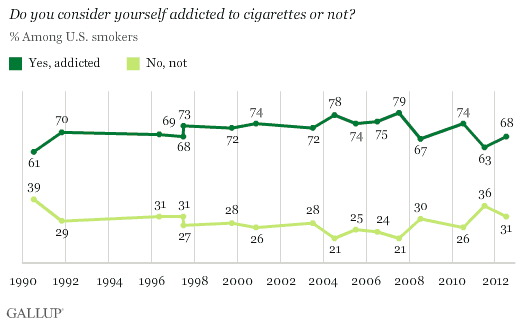WASHINGTON, D.C. -- Only 1% of U.S. smokers say they smoke more than one pack of cigarettes per day, while 68% smoke less than a pack a day, each a record in Gallup trends dating to 1944. The percentage of one-pack-a-day smokers -- now at 31% -- has stayed relatively constant.

The findings are from Gallup's annual consumption poll, conducted July 9-12, 2012, which measures Americans' smoking behavior and attitudes. It is possible that the decline in reports of smoking is the result of respondents' awareness that smoking is socially undesirable. Therefore, respondents may aim to present themselves in the best possible light to the interviewer and underestimate the amount they truly smoke.
Still, the trend toward less smoking among smokers is clear. Prior to 1999, with one exception, less than half of U.S. smokers said they smoked less than one pack of cigarettes each day. The percentage smoking more than a pack a day peaked at 30% in 1978 but fell below 20% in 1987 and below 10% in 1999.
Even though, on average, U.S. smokers are lighting up less each day, more than two-thirds of smokers -- 68% -- still say they are addicted to cigarettes. The percentage of smokers who currently say they are addicted has fluctuated slightly from year to year; in 2007, nearly eight in 10 smokers said they were addicted to cigarettes.

Smokers Regret Ever Smoking and Most Want to Give It Up
The overwhelming majority of smokers still regret that they ever started to smoke. Nearly nine in 10 (88%) say if they could do it over again, they would not have started smoking -- up slightly from 83% in 1990, the first time Gallup asked this question.

While 88% of smokers say they wish they had never started smoking, fewer -- 78% -- say they would like to give it up. The percentage of smokers who want to quit has remained generally steady since 1997, but exceeds the 66% in the late 1970s and early 1980s who said they wanted to give up smoking.

Bottom Line
In the U.S., the percentage of heavy smokers has dropped significantly since the late 1970s, and has reached an all-time low this year. The record-low daily cigarette consumption level coincides with a U.S. smoking prevalence rate that is tied for the all-time low. That number could go still lower because most U.S. smokers say they would like to quit, an attitude that underscores how difficult it is for smokers to stop. These self-reports also suggest that attempts to give smokers rational information about smoking's harmful effects may not be highly effective, because most smokers already appear to be aware of the habit's down side and have a rational desire to quit.
Gallup's annual consumption survey and the Gallup-Healthways Well-Being Index survey will continue to monitor smoking patterns and attitudes in future years.
Survey Methods
Results for this Gallup poll are based on telephone interviews conducted July 9-12, 2012, with a random sample of 1,014 adults, aged 18 and older, living in all 50 U.S. states and the District of Columbia.
For results based on the sample of 166 smokers, the maximum margin of sampling error is ±10 percentage points.
Interviews are conducted with respondents on landline telephones and cellular phones, with interviews conducted in Spanish for respondents who are primarily Spanish-speaking. Each sample includes a minimum quota of 400 cell phone respondents and 600 landline respondents per 1,000 national adults, with additional minimum quotas among landline respondents by region. Landline telephone numbers are chosen at random among listed telephone numbers. Cell phone numbers are selected using random-digit-dial methods. Landline respondents are chosen at random within each household on the basis of which member had the most recent birthday.
Samples are weighted by gender, age, race, Hispanic ethnicity, education, region, adults in the household, and phone status (cell phone only/landline only/both, cell phone mostly, and having an unlisted landline number). Demographic weighting targets are based on the March 2011 Current Population Survey figures for the aged 18 and older non-institutionalized population living in U.S. telephone households. All reported margins of sampling error include the computed design effects for weighting and sample design.
In addition to sampling error, question wording and practical difficulties in conducting surveys can introduce error or bias into the findings of public opinion polls.
View methodology, full question results, and trend data.
For more details on Gallup's polling methodology, visit www.gallup.com.
